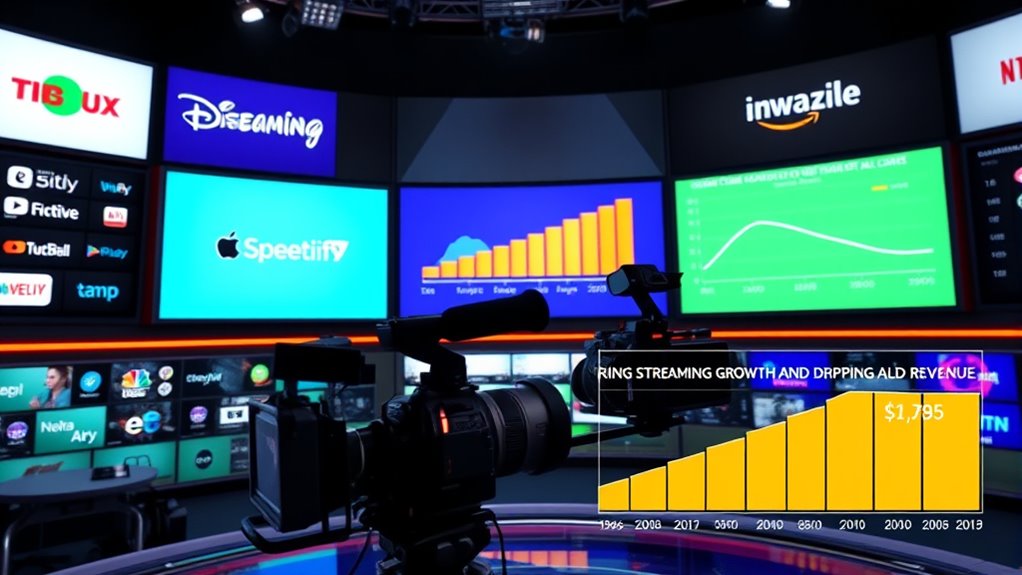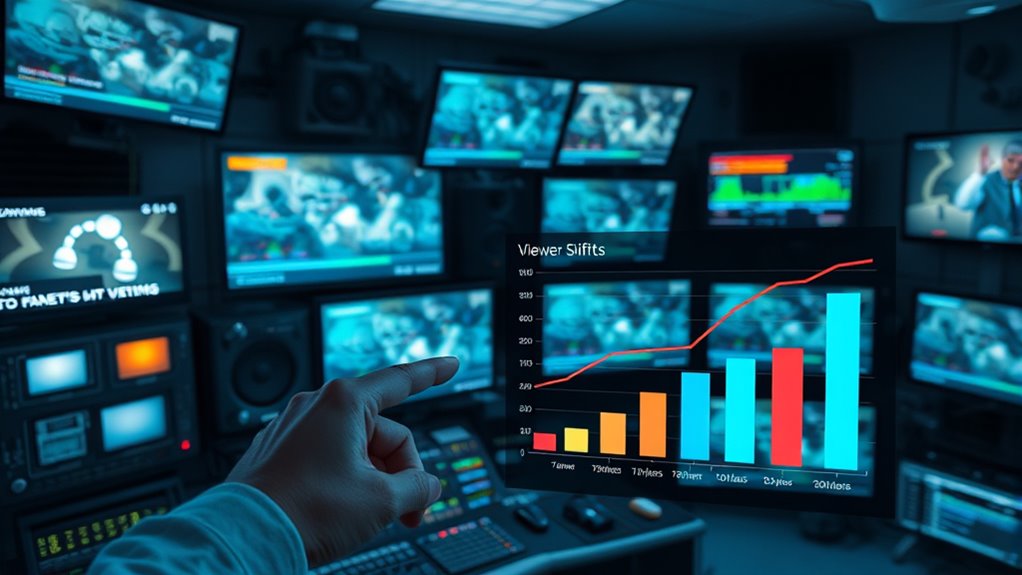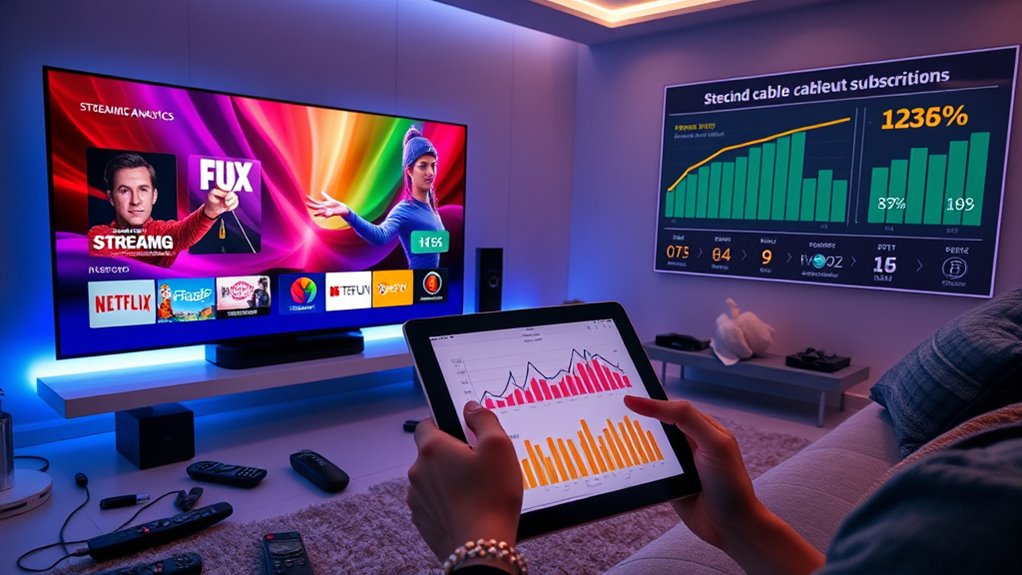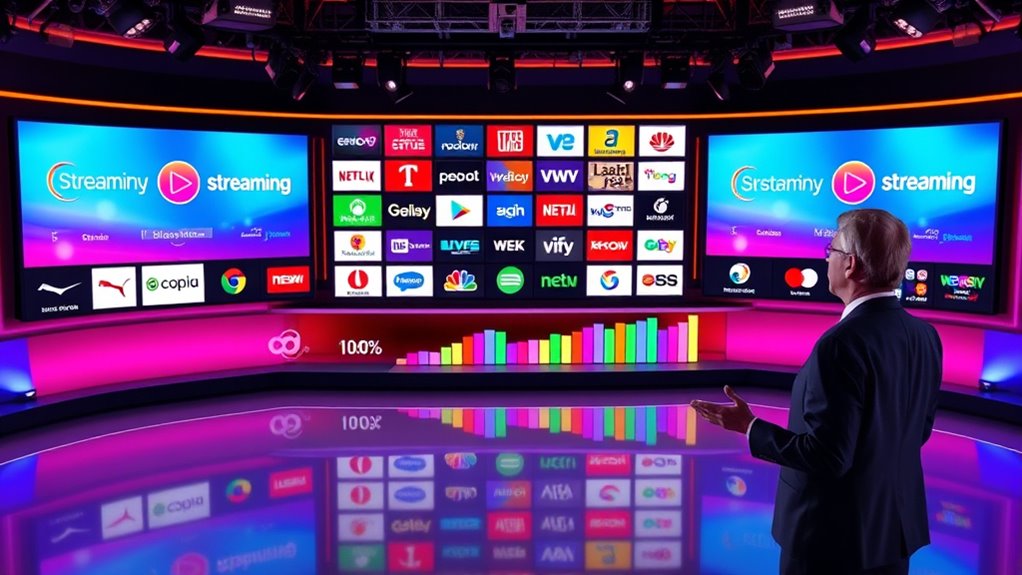As streaming grows rapidly, you’ll notice fewer people tuning into traditional cable channels, especially among younger viewers. Advertisers are shifting their budgets to streaming platforms because they offer targeted, measurable ads and higher engagement. This trend means less revenue for cable providers and more investment in digital content. If you want to understand how these changes impact your favorite shows and ad experiences, there’s much more to explore below.
Key Takeaways
- Streaming’s rise reduces traditional cable viewership, leading to decreased cable channel ratings and revenue.
- Advertisers shift budget from cable to streaming platforms for better targeting and measurable results.
- Cable subscriptions decline, especially among younger viewers, impacting cable channel profitability.
- Streaming services’ personalized content and ads increase viewer engagement, drawing ad dollars away from cable.
- Technological innovations enhance streaming accessibility, further accelerating the decline of cable channels and traditional ad spend.
The Rise of Streaming and Its Market Penetration

The rise of streaming has dramatically transformed the television landscape, with platforms now reaching a vast majority of viewers. Today, 83% of U.S. adults use streaming services regularly, making it the dominant way to watch TV. Streaming accounts for nearly 45% of all TV viewing, surpassing traditional broadcast and cable combined. Since 2021, streaming usage has grown by 71%, reflecting its rapid adoption. Younger audiences, especially those under 50, heavily favor streaming, with nine out of ten using these services regularly. The variety of content available on streaming platforms is a major driver of their popularity, offering everything from movies and shows to niche genres. This shift is reshaping how viewers access and consume entertainment worldwide. Additionally, the decline in traditional cable subscriptions is leading advertisers to reallocate their budgets toward digital and streaming platforms, affecting overall ad sales in the industry.
Decline of Traditional Cable Viewership and Subscriber Trends

As streaming services gain popularity, traditional cable viewership continues to decline sharply across the United States. You’ll notice fewer people subscribing to cable, especially among younger demographics. The trend of cord-cutting accelerates as more viewers prefer the flexibility and content variety streaming offers. This shift leads to a significant drop in cable subscribers and viewership numbers, reaching historic lows in 2025.
- Cable subscriptions are now more common among older adults, with 64% of those 65+ still subscribing.
- Younger viewers, especially under 50, increasingly prefer streaming, reducing cable’s relevance.
- Cable’s share of TV viewership drops as streaming accounts for nearly half of all viewing time.
- The decline in cable subscriptions also impacts advertising revenue for cable channels, prompting many to seek alternative ad sales strategies.
This ongoing decline reshapes the traditional TV landscape, forcing cable providers to adapt or lose relevance.
Shifting Advertising Dollars From Cable to Streaming Platforms

Have advertising dollars truly shifted from traditional cable to streaming platforms? The evidence suggests yes. As more viewers migrate to streaming, advertisers follow to reach their target audiences more effectively. Streaming platforms offer targeted ads based on user data, making campaigns more efficient and appealing to brands. Netflix and other services have reported record ad sales, indicating increased confidence from advertisers. Meanwhile, cable TV’s declining viewership reduces its attractiveness for ad spend, forcing companies to reallocate budgets. The shift isn’t just about numbers; it’s about strategy. Advertisers now prioritize platforms that deliver precise targeting, measurable results, and higher engagement. Consequently, a significant portion of advertising dollars is moving away from cable, fueling growth and innovation in the streaming advertising landscape. Additionally, the rise of content personalization on streaming platforms enhances ad relevance, further accelerating the transition of ad dollars.
Technological Innovations Fueling Streaming Dominance

Technological innovations are propelling streaming services to new heights, making them more accessible and appealing than ever before. These advancements allow you to easily watch content across devices, ensuring seamless viewing wherever you are. High-speed internet, 4K streaming, and smart devices have transformed how you consume entertainment. You benefit from personalized recommendations that keep you engaged, while improvements in content delivery reduce buffering and lag. Platforms are also investing in user interfaces that are intuitive and easy to navigate. Additionally, the integration of AI in content suggestions and on-device AI capabilities enhances user experiences further.
Consumer Preferences and Future Industry Directions

Consumer preferences are increasingly driving the evolution of the entertainment industry, with viewers valuing convenience, content diversity, and personalized experiences. You want instant access on your favorite devices, so streaming platforms focus on seamless usability across smartphones, tablets, and smart TVs. The wide variety of content—from movies and shows to niche genres—keeps you engaged and offers choices traditional TV can’t match. You also prefer personalized recommendations, making content discovery effortless. As a result, you’ll likely continue favoring streaming over cable, especially since younger audiences under 50 mainly use these services. Media companies are responding by expanding content libraries and integrating new features like gaming. Future industry directions will cater even more to your preferences, emphasizing customization, accessibility, and on-demand viewing to stay competitive. Incorporating innovative features like content efficiency will further enhance user experience and satisfaction.
Frequently Asked Questions
How Do Streaming Services Impact Local Broadcasting Networks?
Streaming services challenge local broadcasting networks by drawing viewers away, especially younger demographics, which reduces their audience and ad revenue. You’ll notice fewer people tune in to local channels as more turn to streaming for content. This shift forces local networks to adapt, offering their own online options or focusing on niche content like news and sports to stay relevant. The trend indicates a significant change in how audiences consume local programming.
What Are the Long-Term Effects of Cord-Cutting on Cable Infrastructure?
As cord-cutting gradually redefines the TV landscape, you’ll notice a shift in cable infrastructure investment. Fewer subscribers mean less demand for traditional wiring and equipment, prompting providers to downsize or reimagine their networks. Over time, this evolution encourages a focus on flexible, digital solutions, making way for innovative delivery methods. You’ll see a transformation that aligns with changing viewer habits, shaping a more streamlined, adaptable communication infrastructure.
How Do Streaming Platforms Personalize Targeted Advertising?
Streaming platforms personalize targeted advertising by collecting data on your viewing habits, preferences, and search history. They analyze this information to deliver ads tailored specifically to your interests, making them more relevant and engaging. You might notice ads for products or services related to your favorite genres or past interactions. This personalized approach helps platforms attract more advertisers and increases ad effectiveness, benefiting both users and streaming services.
What Role Does User Password Sharing Play in Subscription Revenue?
You should know that password sharing impacts subscription revenue by allowing multiple users to access accounts without paying for additional subscriptions. This means fewer new subscriptions are generated, and revenue is diluted since one paid account can serve several viewers. While it boosts overall engagement and content exposure, it creates challenges for streaming services trying to grow revenue and justify content investment, potentially leading to stricter sharing policies.
How Will Emerging Technologies Like 5G Influence Streaming Adoption?
Imagine 5G as a lightning bolt, electrifying your connection speed and access. It’ll make streaming faster, smoother, and more reliable, encouraging you to watch on the go without buffering delays. With 5G, you’ll enjoy richer content, immersive experiences, and instant downloads. This technology will push streaming adoption even higher, transforming how you consume media daily, making it more seamless, personalized, and integrated into every moment of your life.
Conclusion
As streaming continues to carve out its territory, you need to stay ahead of the curve. The writing’s on the wall for traditional cable, as ad dollars and viewers shift gears. Embrace the change now before you’re caught between a rock and a hard place, unable to keep up. The industry’s evolution is like a river flowing swiftly—resist it, and you risk being left behind in its wake.










